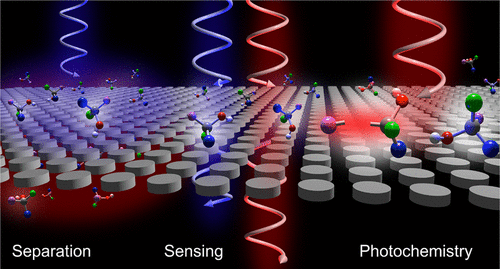当前位置:
X-MOL 学术
›
Acc. Chem. Res.
›
论文详情
Our official English website, www.x-mol.net, welcomes your
feedback! (Note: you will need to create a separate account there.)
Nanophotonic Platforms for Chiral Sensing and Separation.
Accounts of Chemical Research ( IF 16.4 ) Pub Date : 2020-01-08 , DOI: 10.1021/acs.accounts.9b00460 Michelle L Solomon 1 , Amr A E Saleh 1, 2 , Lisa V Poulikakos 1 , John M Abendroth 1 , Loza F Tadesse 3 , Jennifer A Dionne 1, 4
Accounts of Chemical Research ( IF 16.4 ) Pub Date : 2020-01-08 , DOI: 10.1021/acs.accounts.9b00460 Michelle L Solomon 1 , Amr A E Saleh 1, 2 , Lisa V Poulikakos 1 , John M Abendroth 1 , Loza F Tadesse 3 , Jennifer A Dionne 1, 4
Affiliation

|
Chirality in Nature can be found across all length scales, from the subatomic to the galactic. At the molecular scale, the spatial dissymmetry in the atomic arrangements of pairs of mirror-image molecules, known as enantiomers, gives rise to fascinating and often critical differences in chemical and physical properties. With increasing hierarchical complexity, protein function, cell communication, and organism health rely on enantioselective interactions between molecules with selective handedness. For example, neurodegenerative and neuropsychiatric disorders including Alzheimer's and Parkinson's diseases have been linked to distortion of chiral-molecular structure. Moreover, d-amino acids have become increasingly recognized as potential biomarkers, necessitating comprehensive analytical methods for diagnosis that are capable of distinguishing l- from d-forms and quantifying trace concentrations of d-amino acids. Correspondingly, many pharmaceuticals and agrochemicals consist of chiral molecules that target particular enantioselective pathways. Yet, despite the importance of molecular chirality, it remains challenging to sense and to separate chiral compounds. Chiral-optical spectroscopies are designed to analyze the purity of chiral samples, but they are often insensitive to the trace enantiomeric excess that might be present in a patient sample, such as blood, urine, or sputum, or pharmaceutical product. Similarly, existing separation schemes to enable enantiopure solutions of chiral products are inefficient or costly. Consequently, most pharmaceuticals or agrochemicals are sold as racemic mixtures, with reduced efficacy and potential deleterious impacts.Recent advances in nanophotonics lay the foundation toward highly sensitive and efficient chiral detection and separation methods. In this Account, we highlight our group's effort to leverage nanoscale chiral light-matter interactions to detect, characterize, and separate enantiomers, potentially down to the single molecule level. Notably, certain resonant nanostructures can significantly enhance circular dichroism for improved chiral sensing and spectroscopy as well as high-yield enantioselective photochemistry. We first describe how achiral metallic and dielectric nanostructures can be utilized to increase the local optical chirality density by engineering the coupling between electric and magnetic optical resonances. While plasmonic nanoparticles locally enhance the optical chirality density, high-index dielectric nanoparticles can enable large-volume and uniform-sign enhancements in the optical chirality density. By overlapping these electric and magnetic resonances, local chiral fields can be enhanced by several orders of magnitude. We show how these design rules can enable high-yield enantioselective photochemistry and project a 2000-fold improvement in the yield of a photoionization reaction. Next, we discuss how optical forces can enable selective manipulation and separation of enantiomers. We describe the design of low-power enantioselective optical tweezers with the ability to trap sub-10 nm dielectric particles. We also characterize their chiral-optical forces with high spatial and force resolution using combined optical and atomic force microscopy. These optical tweezers exhibit an enantioselective optical force contrast exceeding 10 pN, enabling selective attraction or repulsion of enantiomers based on the illumination polarization. Finally, we discuss future challenges and opportunities spanning fundamental research to technology translation. Disease detection in the clinic as well as pharmaceutical and agrochemical industrial applications requiring large-scale, high-throughput production will gain particular benefit from the simplicity and relative low cost that nanophotonic platforms promise.
中文翻译:

用于手性传感和分离的纳米光子平台。
从亚原子到银河,在所有长度尺度上都可以发现自然界中的手性。在分子规模上,成对的镜像分子对(称为对映异构体)的原子排列中的空间不对称性引起了化学和物理性质的引人入胜且通常是关键的差异。随着层次结构复杂性的增加,蛋白质功能,细胞通讯和生物健康依赖于具有选择性操纵性的分子之间的对映选择性相互作用。例如,包括阿尔茨海默氏病和帕金森氏病在内的神经退行性疾病和神经精神疾病与手性分子结构的畸变有关。而且,d-氨基酸已被越来越多地认为是潜在的生物标志物,需要用于诊断的综合分析方法,该方法应能够区分L型和D型并定量痕量D型氨基酸。相应地,许多药物和农用化学品由靶向特定对映选择性途径的手性分子组成。然而,尽管分子手性的重要性,但感觉和分离手性化合物仍然具有挑战性。手性光学光谱仪旨在分析手性样品的纯度,但它们通常对患者样品(例如血液,尿液或痰液或药品)中可能存在的微量对映体过量不敏感。同样,现有的分离方案能够实现手性产物的对映纯溶液效率低下或成本高昂。所以,大多数药物或农用化学药品都以消旋混合物的形式出售,降低了功效并可能产生有害影响。纳米光子学的最新进展为高度灵敏和高效的手性检测和分离方法奠定了基础。在本报告中,我们强调了我们小组利用纳米级手性光-物质相互作用来检测,表征和分离对映异构体(可能降至单个分子水平)的努力。值得注意的是,某些共振纳米结构可以显着增强圆二色性,以改善手性传感和光谱学以及高产率的对映选择性光化学。我们首先描述如何通过设计电和磁光学共振之间的耦合来利用非手性金属和介电纳米结构来增加局部光学手性密度。虽然等离激元纳米颗粒局部增强了光学手性密度,但高折射率介电纳米颗粒可以使光学手性密度大而均匀地增强。通过重叠这些电和磁共振,可以将局部手性场增强几个数量级。我们展示了这些设计规则如何能够实现高收率的对映选择性光化学反应,并预测光电离反应的收率提高了2000倍。接下来,我们讨论光学力如何能够实现对映异构体的选择性操纵和分离。我们描述了具有捕获低于10 nm介电粒子能力的低功率对映选择性光镊的设计。我们还使用组合的光学和原子力显微镜,以高空间和力分辨率表征了它们的手性光学力。这些光镊表现出超过10 pN的对映选择性光学力对比,能够根据照明偏振选择性吸引或排斥对映体。最后,我们讨论了从基础研究到技术翻译的未来挑战和机遇。纳米光子平台所承诺的简单性和相对较低的成本,将在需要大规模,高通量生产的诊所以及制药和农用化学工业应用中实现疾病检测,从而获得特别的收益。
更新日期:2020-01-08
中文翻译:

用于手性传感和分离的纳米光子平台。
从亚原子到银河,在所有长度尺度上都可以发现自然界中的手性。在分子规模上,成对的镜像分子对(称为对映异构体)的原子排列中的空间不对称性引起了化学和物理性质的引人入胜且通常是关键的差异。随着层次结构复杂性的增加,蛋白质功能,细胞通讯和生物健康依赖于具有选择性操纵性的分子之间的对映选择性相互作用。例如,包括阿尔茨海默氏病和帕金森氏病在内的神经退行性疾病和神经精神疾病与手性分子结构的畸变有关。而且,d-氨基酸已被越来越多地认为是潜在的生物标志物,需要用于诊断的综合分析方法,该方法应能够区分L型和D型并定量痕量D型氨基酸。相应地,许多药物和农用化学品由靶向特定对映选择性途径的手性分子组成。然而,尽管分子手性的重要性,但感觉和分离手性化合物仍然具有挑战性。手性光学光谱仪旨在分析手性样品的纯度,但它们通常对患者样品(例如血液,尿液或痰液或药品)中可能存在的微量对映体过量不敏感。同样,现有的分离方案能够实现手性产物的对映纯溶液效率低下或成本高昂。所以,大多数药物或农用化学药品都以消旋混合物的形式出售,降低了功效并可能产生有害影响。纳米光子学的最新进展为高度灵敏和高效的手性检测和分离方法奠定了基础。在本报告中,我们强调了我们小组利用纳米级手性光-物质相互作用来检测,表征和分离对映异构体(可能降至单个分子水平)的努力。值得注意的是,某些共振纳米结构可以显着增强圆二色性,以改善手性传感和光谱学以及高产率的对映选择性光化学。我们首先描述如何通过设计电和磁光学共振之间的耦合来利用非手性金属和介电纳米结构来增加局部光学手性密度。虽然等离激元纳米颗粒局部增强了光学手性密度,但高折射率介电纳米颗粒可以使光学手性密度大而均匀地增强。通过重叠这些电和磁共振,可以将局部手性场增强几个数量级。我们展示了这些设计规则如何能够实现高收率的对映选择性光化学反应,并预测光电离反应的收率提高了2000倍。接下来,我们讨论光学力如何能够实现对映异构体的选择性操纵和分离。我们描述了具有捕获低于10 nm介电粒子能力的低功率对映选择性光镊的设计。我们还使用组合的光学和原子力显微镜,以高空间和力分辨率表征了它们的手性光学力。这些光镊表现出超过10 pN的对映选择性光学力对比,能够根据照明偏振选择性吸引或排斥对映体。最后,我们讨论了从基础研究到技术翻译的未来挑战和机遇。纳米光子平台所承诺的简单性和相对较低的成本,将在需要大规模,高通量生产的诊所以及制药和农用化学工业应用中实现疾病检测,从而获得特别的收益。











































 京公网安备 11010802027423号
京公网安备 11010802027423号